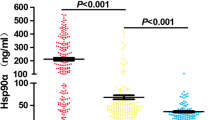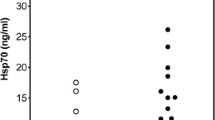Abstract
Tumor growth and metastasis in nasopharyngeal carcinoma (NPC) patients recent research stated that intracellular Hsp70 is a stress protein as the main factor for the growth, invasion and metastasis of NPC. To analyze intracellular Hsp70 protein expression of NPC patients which correlate with staging of NPC as clinical manifestation. Formalin-fixed paraffin-embedded biopsy specimens from 20 NPCs histopathology and clinically. The expression of intracellular Hsp70 was obtained using monoclonal antibody of Anti Human Hsp70 from Santa Cruz Biotechnology, California, USA. The assessment of the staining was performed with Remmele methode by Histopathologies doctor Consultant. 20 NPC patients met the inclusion and exclusion criteria. The data showed a negative intracellular of Hsp70 expression by 15% for all sample that consist of 1 patient of stage I, II, III, and none for stage IV. Then, followed by 25% of mild positive intracellular Hsp70 expression which consisted of 0 patient of stage I and III, 2 patients of stage II, and 3 patients of stage IV. Followed by 50% of moderate positive intracellular Hsp70 expression which consisted of 0 patient of stage I and II, 1 patient of stage III, and 9 patients of stage IV. Spearman test results test scored p = 0.001 with a correlation coefficient of 0.671. The correlation of intracellular Hsp70 protein expression with stage (I, II, III, and IV) in NPC patients was significant (p < 0.05). There was a correlation between increased intracellular Hsp70 expression and the stage of patients with nasopharyngeal carcinoma.




Similar content being viewed by others
References
Ballenger JJ (1994) Karsinoma nasofaring. In: Ballenger JJ (ed) Dalam. Penyakit telinga hidung tenggorok kepala dan leher (alih bahasa). Edisi ke-13, edn. Bina Rupa Aksara, Jakarta
Peng ZLN, Huang D, Duan C, Li Y, Tang X (2013) N,N′-dinitrosopiperazine-mediated heat-shock protein70-2 expression is involved in metastasis of nasopharyngeal carcinoma. J Pone 8(5):1–11
Liao Q, Zhao L, Chen X, Deng Y, Ding Y (2008) Serum proteome analysis for profiling protein markers associated with carcinogenesis and lymph node metastasis in nasopharyngeal carcinoma. Clin Exp Metas 25(4):465–476. https://doi.org/10.1007/s10585-008-9152-8
Proctor CJ, Lorimer IA (2011) Modelling the role of the Hsp70/Hsp90 system in the maintenance of protein homeostasis. PLoS ONE 6(7):e22038. https://doi.org/10.1371/journal.pone.0022038
Srivastava P (2002) Interaction of heat shock protein with peptides and antigen presenting cells: chaperoning of the innate and adaptive immune responses. Annu Rev Immunol 20:395–425
Sreedhar CS (2004) Heat shock proteins in the regulation of apoptosis: new strategies in tumor therapy: a comprehensive review. J Pharmther 101:227–257
Cai MWX, Zhang J, Han H, Liu C, Bei J et al (2012) Expression of heat shock protein70 in nasopharyngeal carcinomas: different expression patterns correlate with distinct clinical prognosis. J Transl Med 10(96):1–10
Mulyarjo (2002) Diagnosis dan penatalaksanaan karsinoma nasofaring. In: Mulyarjo D, Soedjak S, Wisnubroto, Harmadji SM, Hasanusi S, Artono R (eds) Dalam. Naskah Lengkap Pendidikan Kedokteran Berkelanjutan III Ilmu Kesehatan THT-KL. Surabaya: Laboratorium/SMF Ilmu Penyakit THT-KL FK Unair/RSUD Dr. Soetomo
Kentjono WA (2010) Karsinoma nasofaring: etiologi, gejala, diagnosis, deteksi dini, terapi dan pencegahan. In: Kentjono WA (ed) Dalam. Pelatihan deteksi dini kanker nasofaring untuk dokter umum di puskesmas. Dept/SMF Ilmu Kesehatan THT-KL FK Unair/RSUD Dr. Soetomo, Surabaya
Zeng MS (2010) Pathogenesis and etiology of nasopharyngeal carcinoma. Nasopharyngeal Cancer Multidisciplinary Management. Springer, Berlin, pp 12–20
Suwondo S (2012) Validitas hasil pemeriksaan biopsi dengan tuntunan narrow band imaging pada penderita suspek karsinoma nasofaring. Dalam: Karya Akhir untuk memperoleh ijazah keahlian Ilmu Kesehatan Telinga Hidung Tenggorok Bedah Kepala dan Leher. Departemen/SMF Ilmu Kesehatan THT-KL FK UA/RSUD Dr. Soetomo Surabaya
Harahap MPH (2009) Ekspresi vascular endothelial growth factor pada karsinoma nasofaring. Universitas Sumatra Utara Repository, Medan
Chang ET, Adami HO (2006) The enigmatic epidemiology of nasopharyngeal carcinoma. Cancer Epidemiol Biomark Prev 15(10):1765–1777. https://doi.org/10.1158/1055-9965.EPI-06-0353
Arisakti MA (2013) Hubungan ekspresi vascular endothelial growth factor dengan nodul limfe servikal pada karsinoma nasofaring. Dalam: Karya Akhir untuk memperoleh ijazah keahlian Ilmu Kesehatan Telinga Hidung Tenggorok Bedah Kepala dan Leher, Surabaya
Ma JCS (2010) The epidemiology of nasopharyngeal cancer. In: Lu JJ, Cooper JS, Lee AWM (eds) Nasopharyngeal Cancer Multidisciplinary Management. Springer, Berlin, pp 2–6
Li WRR, Gao DL, Fitzgibbons ED, Seixos NS, Camp JE, Wernli KJ, Astrakianakis G, Feng Z, Thomas DB, Checkoway H (2005) Occupational risk factors for nasopharyngeal cancer among female textile workers in Shanghai China. Occup Environ Med 63:39–44
Pathmanathan R (1997) Pathology. In: Chong VJH, Tsao SY (eds) Nasopharyngeal carcinoma. Armour Publishing, Singapore, pp 6–13
Adham MKA, Muhtadi AI, Roezin A, Hermani B, Gondhowiardjo S et al (2012) Nasopharyngeal carcinoma in Indonesia: epidemiology, incidence, signs, and symptoms at presentation. J Cancer Res Ther 31:185 (in Chinese)
Jones EL, Zhao MJ, Stevenson MA, Calderwood SK (2004) The 70 kilodalton heat shock protein is an inhibitor of apoptosis in prostate cancer. Int J Hyperth 20(8):835–849. https://doi.org/10.1080/02656730410001721807
Bhatt ANMR, Farooque A, Verma A, Dwarakanath BS (2010) Cancer biomarkers—current perspectives. Indian J Med Res 132:129–149
Arya R, Mallik M, Lakhotia SC (2007) Heat shock genes-integrating cell survival and death. J Biosci 32(3):595–610
Author information
Authors and Affiliations
Corresponding author
Rights and permissions
About this article
Cite this article
Mustikaningtyas, E., Juniati, S.H. & Romdhoni, A.C. Intracell Heat Shock Protein 70 Expression and Nasopharyngeal Carcinoma Stage. Indian J Otolaryngol Head Neck Surg 71 (Suppl 1), 321–326 (2019). https://doi.org/10.1007/s12070-018-1299-2
Received:
Accepted:
Published:
Issue Date:
DOI: https://doi.org/10.1007/s12070-018-1299-2




